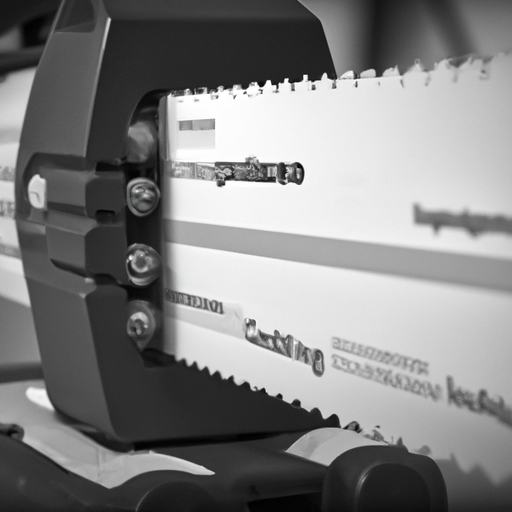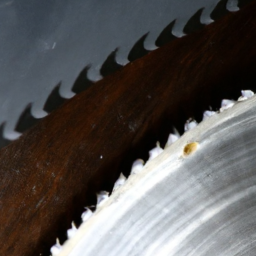Electric chainsaws have become increasingly popular for their convenience and ease of use. But have you ever wondered if these electric counterparts are prone to the dangerous phenomenon of kickback, just like their gas-powered counterparts? In this article, we will explore the potential risks of kickback when using electric chainsaws and provide valuable insights on how to safely operate these tools without compromising your safety.
What is Kickback?
Kickback refers to the sudden upward and backward motion of a chainsaw when the chain at the tip of the bar encounters an object or gets pinched. This sudden motion can catch operators off guard and cause them to lose control of the chainsaw, leading to serious injuries or accidents.
Causes of Kickback
Several factors contribute to kickback, including the design and operation of the chainsaw, as well as the technique used by the operator. When the chain at the tip of the bar comes into contact with a solid object, such as a log or a branch, it can cause the chainsaw to kick back. Additionally, if the chain gets pinched in the wood during a cut, it can also lead to kickback.
Can Electric Chainsaws Kickback?
Contrary to popular belief, electric chainsaws are not immune to kickback. While they may have some features that make them less prone to kickback compared to gas chainsaws, electric chainsaws can still experience kickback under certain circumstances.
Comparison with Gas Chainsaws
Gas chainsaws and electric chainsaws have some key differences in terms of power source and design. Gas chainsaws are typically more powerful and have a larger chain and bar, increasing the potential for kickback. Electric chainsaws, on the other hand, have smaller bars and chains, which may reduce the risk of kickback to some extent. However, it is important to note that the potential for kickback still exists with electric chainsaws.
Factors that Affect Kickback Potential
Various factors can affect the kickback potential of an electric chainsaw. The chain tension, chain sharpness, and guide bar length all play a role in determining the likelihood of kickback. Additionally, the user’s technique and body positioning while operating the chainsaw can significantly impact the risk of kickback.
Safety Measures to Prevent Kickback
To minimize the risk of kickback when using an electric chainsaw, it is crucial to follow proper safety measures and techniques.
Proper Chainsaw Technique
One of the most effective ways to prevent kickback is by using proper chainsaw technique. This includes maintaining a firm grip on the chainsaw with both hands, keeping the thumb wrapped around the handle, and using a balanced stance. It is also important to avoid cutting with the nose of the bar and to keep the chainsaw away from the operator’s body.
Using a Kickback Bar
Some electric chainsaws are equipped with a kickback bar, also known as a tip guard or tip protector. This additional safety feature is designed to minimize contact with solid objects at the tip of the bar, reducing the risk of kickback. It is recommended to use a chainsaw with a kickback bar and to ensure that it is properly installed and maintained.
Wearing Protective Gear
When operating a chainsaw, regardless of the type, it is essential to wear appropriate protective gear. This includes a helmet with face and ear protection, goggles or safety glasses, gloves, and sturdy footwear. Wearing protective clothing can provide an added layer of safety in the event of kickback or other accidents.
Important Elements of a Chainsaw to Minimize Kickback
Certain features and elements of a chainsaw can help minimize the risk of kickback when properly maintained and utilized.
Chain Brake
A chain brake is a safety mechanism that is designed to stop the chain from rotating in the event of kickback or other emergencies. This feature can prevent further damage or injury when activated quickly by the operator. It is important to regularly inspect and test the chain brake to ensure that it is functioning correctly.
Chain Design
The design and configuration of the chain can impact the likelihood of kickback. Chains with low-kickback features, such as safety or anti-kickback chains, are designed to reduce the severity of kickback or prevent it altogether. Choosing the right chain design for the specific cutting application can help minimize the risk of kickback.
Chain Tension
Maintaining the proper tension of the chain is crucial for safe chainsaw operation. A loose chain can increase the likelihood of kickback, while an overly tight chain can put excessive strain on the chainsaw and decrease cutting efficiency. Regularly checking and adjusting the chain tension to the manufacturer’s recommended specifications is essential.
Chain Sharpness
A sharp chain is not only more efficient in cutting but also reduces the likelihood of kickback. A dull or damaged chain can cause the chainsaw to bind or pinch in the wood, leading to kickback. Regular sharpening of the chain and replacing it when necessary is vital for safe and effective chainsaw operation.
Guide Bar Length
The length of the guide bar, which is where the cutting chain is housed, can influence the potential for kickback. Longer guide bars provide increased cutting capacity but also have a greater tendency for kickback. It is important to select a guide bar length that is appropriate for the task at hand and matches the user’s skill level and experience.
Common Myths About Electric Chainsaw Kickback
There are some common misconceptions surrounding electric chainsaw kickback, which can lead to unsafe practices. It is important to address these myths and provide accurate information.
Electric Chainsaws are Safer
While electric chainsaws may have certain features that make them safer to operate, such as reduced noise and emissions, they are not entirely immune to kickback. Electric chainsaws can still experience kickback under specific circumstances, and operators should not assume they are completely safe from this risk.
Kickback Only Occurs with Gas Chainsaws
Kickback can occur with both gas and electric chainsaws. It is a result of the interaction between the chain, the bar, and the wood being cut, rather than the type of chainsaw being used. Operators of electric chainsaws should be aware of the potential for kickback and take appropriate precautions.
Understanding and Reacting to Kickback
Knowing how to recognize the warning signs of kickback and how to react in those situations is crucial for maintaining safety while operating a chainsaw.
Recognizing the Warning Signs
There are several warning signs that may indicate an imminent kickback. These include the chainsaw suddenly jerking or being forced out of the cut, the noise or pitch of the chainsaw changing, and the nose of the bar being pressed down or into the wood. Being vigilant and aware of these signs can help operators react quickly and avoid potential accidents.
Proper Body Positioning
Maintaining the correct body positioning while operating a chainsaw is essential for minimizing the risk of kickback and maintaining control of the tool. Operators should stand with their feet shoulder-width apart, place their left hand on the front handle, and their right hand on the rear handle. The body should be positioned to the side of the cutting line, with the chainsaw away from the body.
Actions to Take During Kickback
If kickback occurs, it is crucial to react promptly and appropriately. Operators should release the throttle trigger immediately, maintain a firm grip on the chainsaw, and allow the chain brake to engage. They should also lean back and away from the saw, using their non-cutting hand to push the chainsaw handle outward. This will help the saw move away from the operator and reduce the chance of injury.
Other Risks Associated with Chainsaw Use
While kickback is one of the most significant risks associated with chainsaw use, there are other potential hazards that operators should be aware of.
Sprung or Broken Chains
An improperly tensioned or damaged chain can become loose or break during operation. This can result in the chain being thrown off the bar, posing a serious risk to the operator and bystanders. Regular inspection and maintenance of the chain is essential for preventing this type of accident.
Pinching
Pinching occurs when the chainsaw becomes stuck or pinched in the wood during a cut. This can cause the chainsaw to bind, making it difficult for the operator to regain control. It is important to use proper cutting techniques, such as the plunge cut method, to minimize the risk of pinching and maintain control over the chainsaw.
Recoil Injuries
Recoil injuries can occur when the chainsaw suddenly jerks or pulls back towards the operator due to kickback or other factors. This unexpected movement can cause strain or injury to the operator’s arms, shoulders, or back. Proper technique, body positioning, and awareness of the warning signs of kickback can help prevent recoil injuries.
Comparison: Kickback vs. Other Chainsaw Injuries
While kickback is a well-known risk associated with using chainsaws, it is important to understand how it compares to other types of chainsaw injuries in terms of frequency and severity.
Frequency
Kickback injuries are relatively common and account for a significant number of chainsaw-related accidents. However, other injuries, such as cuts, abrasions, or injuries resulting from contact with the rotating chain, may occur more frequently overall.
Severity
While kickback can potentially lead to serious injuries or accidents, the severity of injuries resulting from kickback may vary depending on various factors, such as the speed and force of the kickback, the location of the operator, and the use of appropriate safety measures. In some cases, kickback injuries can be severe, while in others, they may be relatively minor.
Safety Recommendations for Operating Electric Chainsaws
To ensure safe operation of electric chainsaws and minimize the risk of kickback and other accidents, adherence to certain safety guidelines is essential.
Training and Experience
Operators should receive proper training and have sufficient experience in using electric chainsaws before attempting any cutting tasks. This includes familiarizing themselves with the manufacturer’s instructions and safety guidelines, as well as learning how to recognize and react to kickback situations.
Maintenance and Inspections
Regular maintenance and inspections of the electric chainsaw are crucial for safe operation. This includes checking the chain tension, sharpness, and overall condition, as well as inspecting the chain brake and other safety features. Any necessary repairs or adjustments should be made promptly by qualified professionals.
Safe Work Environment
Creating a safe work environment is vital for preventing accidents and injuries. Operators should ensure that the work area is clear of obstructions, bystanders, and potential hazards. It is also important to consider the weather conditions, such as slippery surfaces, strong winds, or excessive heat, and adjust the work plan accordingly.
First Aid Preparedness
In the event of an accident or injury, it is crucial to have appropriate first aid supplies readily available. Operators should be familiar with basic first aid techniques and have knowledge of how to address common chainsaw-related injuries.
Conclusion
While electric chainsaws may be perceived as safer than their gas counterparts, it is important to recognize that they are not entirely immune to kickback. Understanding the causes of kickback, implementing proper safety measures, and maintaining the chainsaw and related equipment can significantly minimize the risk of kickback and other injuries. By following recommended safety guidelines, operators can ensure a safer and more efficient work environment when operating an electric chainsaw.


